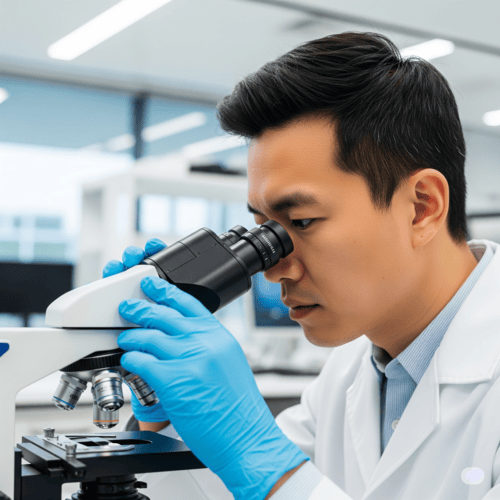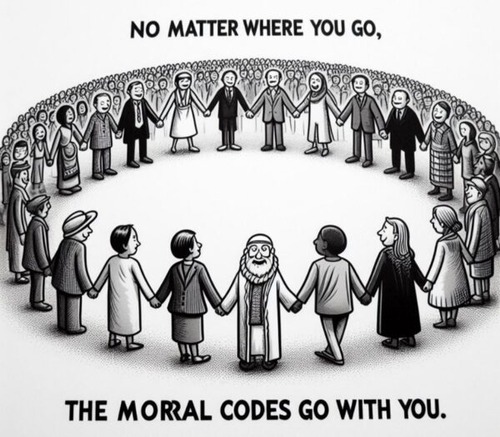Did Life’s Four Building Blocks Assemble by Chance?
HOW SUGARS, AMINO ACIDS, NUCLEOTIDES & LIPIDS DEFY EVOLUTION
Imagine trying to build a skyscraper by throwing steel beams into the air and hoping they land in perfect formation. The odds would be astronomical—so impossible that no reasonable person would attempt it. Yet this is essentially what evolutionary theory asks us to believe about the origin of life.
Every living cell contains four essential chemical building blocks: sugars, amino acids, nucleotides, and lipids. These aren’t simple chemicals like salt or water—they’re precision-engineered molecular machines with complexity that rivals human technology. The evidence from biochemistry provides a resounding answer to whether these molecules could have assembled themselves by random chance: absolutely not.
MEET LIFE’S FOUR ESSENTIAL BUILDING BLOCKS
Before examining why these molecules couldn’t form randomly, let’s understand what they actually do.
- Sugars (carbohydrates) serve as both the fuel and structural framework of life. Glucose, the most important sugar, powers every cellular process. But glucose isn’t just any sugar—it must have the exact three-dimensional shape to fit into the cellular machinery that processes it. Like a key that opens only one specific lock, even slight changes to glucose’s structure render it useless or toxic.
- Amino acids are the building blocks of proteins, the workhorses of every cell. Just 20 standard amino acids combine in countless ways to create millions of different proteins. Each protein performs a specific task—some speed up chemical reactions, others provide structural support, and still others transport materials throughout the cell. The sequence of amino acids determines the protein’s function, much like letters in a sentence create meaning through their precise arrangement.
- Nucleotides form the components of DNA and RNA, the information storage systems of life. The famous four-letter genetic code—A, T, G, and C—contains instructions for building and maintaining every living thing. The DNA in a single human cell contains more information than 1,000 copies of Encyclopaedia Britannica.
- Lipids (fats) form the membranes that surround every cell and its internal compartments. These molecules have a unique property: they spontaneously arrange themselves into double-layered walls, but only under specific conditions. Without these molecular walls, cells would be impossible.
THE PROBLEM OF COMPLEXITY AND SPECIFICITY
The difference between a pile of bricks and a cathedral illustrates the challenge facing evolutionary theory. Both contain the same basic materials, but only one shows evidence of intelligent design. Life’s building blocks represent cathedral-level complexity at the molecular scale.
Consider what “complexity” means in chemistry. Each building block requires its atoms to be arranged in precise three-dimensional patterns. Take haemoglobin, the protein that carries oxygen in your blood. It contains 574 amino acids that must be arranged in exactly the right sequence and folded into exactly the right shape. Change even one amino acid in the wrong position, and you get sickle cell anaemia—a potentially fatal condition.
This specificity requirement creates a statistical nightmare for random assembly. Mathematician William Dembski calculated that the odds of randomly assembling a single functional protein are approximately 1 in 10^164. To put this in perspective, there are only about 10^80 atoms in the observable universe. The odds are so astronomically small that mathematicians consider anything beyond 1 in 10^50 to be effectively impossible.
THE CHIRALITY CHALLENGE: LIFE’S HANDEDNESS PROBLEM
One of the most devastating challenges to evolutionary theory involves something called chirality—the “handedness” of molecules. Just as your left and right hands contain the same parts arranged differently, many molecules come in left-handed and right-handed versions that are mirror images of each other.
Here’s where it gets interesting: life shows an exclusive preference for specific molecular handedness. All amino acids used in living organisms are left-handed. All sugars used in life are right-handed. DNA and RNA consistently use right-handed sugars throughout their structures. This isn’t a minor preference—it’s an absolute requirement. Mixed handedness destroys biological function completely.
The problem for evolutionary theory is that normal chemical reactions produce equal mixtures of left-handed and right-handed molecules. When chemists synthesise amino acids in the laboratory, they get 50% left-handed and 50% right-handed versions. No known natural process can separate these mixtures or preferentially produce one handedness over the other.
THE INTERDEPENDENCE DILEMMA: CHICKEN-AND-EGG PROBLEMS
Perhaps the most intractable problem facing evolutionary explanations is the interdependence of life’s building blocks. They form a web of mutual dependence that makes gradual, step-by-step assembly impossible.
Consider the classic chicken-and-egg problem in molecular biology: proteins need DNA, but DNA needs proteins. DNA contains the instructions for making proteins, but you need protein enzymes to read DNA and manufacture proteins. You also need protein enzymes to copy DNA. Which came first? Neither can exist without the other.
This interdependence extends throughout cellular metabolism. Sugar metabolism requires protein enzymes. Protein synthesis requires energy from nucleotides like ATP. DNA repair requires lipid membranes for protection. Membrane formation requires protein assistance. Remove any component, and the entire system collapses.
The evolutionary problem is obvious: there’s no functional intermediate stage. You can’t have “half a metabolism” or “partial protein synthesis.” The system must work completely from the beginning. This violates the fundamental requirement of evolutionary theory—that complex systems arise through gradual, step-by-step improvements.
INFORMATION CONTENT: THE CODE THAT REQUIRES A CODER
DNA represents something unprecedented in the natural world: a digital information storage system. The four nucleotides function as a four-letter alphabet that stores coded instructions for building and maintaining living organisms. This isn’t metaphorical—it’s literal information in the same sense that computer code contains information.
The information content of DNA is staggering. A single human cell contains about 3 billion base pairs of DNA, equivalent to about 750 megabytes of digital storage. But unlike human data storage, DNA information must be error-free. Even tiny mistakes can cause genetic diseases or death.
This creates a fundamental problem for materialistic explanations of life’s origin. Information theory, established by mathematician Claude Shannon, demonstrates information always requires an intelligent source. Random processes destroy information; they don’t create it. We’ve never observed information arising spontaneously from unintelligent sources.
Consider what happens when you randomly alter the letters in a book. The result isn’t improved information—it’s gibberish. The same principle applies to DNA. Random mutations typically destroy genetic information rather than creating new, useful information.
Programming experience makes this problem vivid. Every programmer knows that functional code requires intelligence, planning, and debugging. Random keystrokes don’t produce working software—they produce crashes. Yet evolutionary theory asks us to believe the most sophisticated information systems we know arose through random processes.
CONDITIONS FOR FORMATION: THE GOLDILOCKS PROBLEM
Life’s four building blocks face another insurmountable challenge: they require precisely controlled conditions to form and remain stable.
- Temperature provides the first challenge. Chemical reactions that form complex biomolecules require specific temperature ranges. Too hot, and the molecules break apart. Too cold, and the reactions won’t occur. The temperature must be maintained within narrow limits throughout the entire process.
- pH levels (acidity/alkalinity) present another critical requirement. Most biomolecules require near-neutral pH to remain stable. Strong acids or bases quickly destroy them. Yet early Earth supposedly had widely varying pH conditions that would have been hostile to delicate organic molecules.
- Concentration represents a third challenge. The right amounts of each starting material must be present simultaneously. Too little, and the reactions won’t proceed. Too much, and harmful side reactions occur. Achieving proper concentrations requires careful control that random processes cannot provide.
- Protection: Perhaps most problematically, these molecules require protection from their environment. Oxygen, essential for complex life, readily destroys organic compounds through oxidation. But without oxygen, other necessary reactions cannot occur. Water is essential for life, yet it also breaks down many biomolecules through hydrolysis.
This creates what chemists call the “oxygen and water paradox.” The very conditions necessary for life also destroy the molecules that make life possible. Living organisms solve this through sophisticated protective mechanisms, but these mechanisms require the very molecules they’re supposed to protect.
THE POSITIVE CASE FOR INTELLIGENT DESIGN
The evidence doesn’t just challenge evolutionary theory—it points positively toward intelligent design. When we apply the scientific method honestly, design emerges as the best explanation for life’s biochemical complexity.
- Observation: Living systems contain complex, specified, interdependent molecular machines that process information and maintain precise conditions.
- Hypothesis: Intelligent design explains the origin of these systems better than random processes.
- Testing: This hypothesis makes testable predictions. If life arose through design, we should expect to find sophisticated engineering principles, quality control systems, and integrated complexity that exceeds anything achieved through random processes.
- Confirmation: Biochemical research consistently confirms these predictions. Molecular machines like ATP synthase operate with near-perfect efficiency. DNA repair mechanisms detect and correct errors with remarkable precision. Protein folding involves quality control systems that prevent malformed molecules from causing damage.
These systems exhibit hallmarks of engineering: purposeful complexity, integrated function, and elegant solutions to mechanical problems. Perhaps most tellingly, these systems show what engineers call “graceful degradation”—they include backup systems, error correction, and redundancy that prevent catastrophic failure. Random processes don’t create such features because they provide no immediate advantage. Only intelligent design explains why living systems include sophisticated protective mechanisms.
LIFE’S FOUR BUILDING BLOCKS: THE DESIGNER’S SIGNATURE
The biochemical evidence reveals what can only be called a designer’s signature throughout living systems. This signature appears in multiple forms, each pointing toward intelligence rather than chance.
Elegant solutions characterise biological systems. The DNA double helix provides both information storage and a mechanism for accurate replication. Protein folding creates three-dimensional structures that accomplish specific tasks with remarkable efficiency. These solutions show the kind of insight and creativity associated with intelligent design.
Purposeful complexity distinguishes biological systems from random complexity. Every component serves specific functions. There are no useless parts, no wasted complexity, no random additions. This goal-directed complexity reflects intelligent planning rather than undirected processes.
Integrated systems reveal coordination that exceeds human engineering. All four building blocks work together seamlessly, each supporting the others in ways that maintain the whole system. This integration requires the kind of foresight and planning that only intelligence can provide.
Creative diversity appears throughout the biological world. While using the same four building blocks, life exhibits countless variations and innovations. This reflects the unlimited creativity of an intelligent designer rather than the constraints of random processes.
LIFE’S FOUR BUILDING BLOCKS: THE VERDICT FROM CHEMISTRY
The evidence from biochemistry provides overwhelming support for intelligent design. Life’s four building blocks exhibit complexity that defies random assembly, specificity that requires careful selection, chirality that demands intelligent separation, interdependence that necessitates coordinated planning, information content that requires an intelligent source, and formation conditions that need careful control.
Each line of evidence, considered individually, creates serious problems for evolutionary theory. Considered together, they form an overwhelming case for intelligent design. The molecules essential for life bear the unmistakable signature of intelligence.
This conclusion doesn’t rest on gaps in our knowledge—it rests on what we do know about chemistry, information theory, and probability. The more we learn about life’s building blocks, the more clearly we see evidence for design.
LIFE’S FOUR BUILDING BLOCKS: RELATED FAQs
What are the four building blocks of life, and why do they point to intelligent design? The four building blocks of life are nucleotides (DNA/RNA), amino acids (proteins), fatty acids (cell membranes), and carbohydrates (energy and structure). Each of these molecular families requires precise chemical arrangements and specific handedness (chirality) to function properly in living systems. The simultaneous emergence of all four building blocks in the correct forms and proportions represents a level of coordination that exceeds what random chemical processes could reasonably produce. This suggests intentional design rather than chance.
- How do creationist scientists explain the origin of biological information in DNA? Leading creationist scientists like Dr Stephen Meyer and Dr Douglas Axe argue DNA’s information content requires an intelligent source, as information always comes from minds in our universal experience. The genetic code demonstrates digital information processing that surpasses human technology, with error-correction mechanisms and programming languages that coordinate cellular functions. Random mutations consistently degrade genetic information rather than creating new functional sequences, making naturalistic information generation statistically implausible.
- What about the Miller-Urey experiment—didn’t it create amino acids from simple chemicals? While the Miller-Urey experiment produced some amino acids under carefully controlled conditions, it also generated tar-like substances that would prevent further chemical evolution and failed to produce the specific left-handed amino acids required for life. The experiment used an artificially designed apparatus with traps to remove products from destructive reactions, conditions that wouldn’t exist in nature. More importantly, creating random amino acids is vastly different from assembling them into functional proteins. This requires precise sequences and folding patterns.
How do creationists address the claim that evolution has been directly observed in laboratories? Creationist scientists distinguish between operational science (observable, testable phenomena) and historical science (inferences about past events). Laboratory observations show organisms adapting within their created kinds through existing genetic variation, not evolving into fundamentally different organisms. Examples like antibiotic resistance in bacteria or beak variations in finches demonstrate designed adaptability mechanisms, not the origin of new genetic information needed for macroevolution.
- What is the significance of homochirality in biological molecules from a design perspective? Homochirality refers to biological molecules having uniform “handedness”—proteins use only left-handed amino acids while DNA uses only right-handed sugars. This uniformity is essential for proper molecular function, yet chemical processes naturally produce equal mixtures of both forms. The exclusive selection and maintenance of one molecular handedness across all life forms suggests a coordinated design plan rather than random chemical evolution.
- How do creationists explain the complexity of cellular membranes and their formation? Cell membranes require specific fatty acid compositions and embedded proteins to maintain selective permeability and cellular integrity. The formation of stable, functional membranes involves coordinated assembly of multiple molecular components that must work together from the beginning. Simple fatty acid vesicles cannot perform the complex transport and signaling functions required for living cells, indicating that membrane systems were designed as integrated units rather than gradually assembled.
What about the mathematical improbability of life arising by chance? Prominent creationist mathematicians and scientists like Dr William Dembski and Dr Scott Minnich have calculated the probability of forming even basic functional proteins by random processes. They discovered it exceeds the universal probability bound (10^-150). The simultaneous requirement for DNA, proteins, and cellular machinery represents a system of irreducible complexity where removing any component destroys function. These calculations suggest that life’s origin requires intelligent causation rather than undirected natural processes.
LIFE’S FOUR BUILDING BLOCKS: OUR RELATED POSTS
- DNA Repair Mechanisms: Engineering Marvel or Random Chance?
- Haemoglobin Screams Design: A Miracle in Every Breath
- The Ankle and Feet: A Miracle of Precision Engineering
- Our Consciousness and Rationality: Is God the Best Explanation?
- DNA Evidence for Intelligent Design: New Challenges for Evolution
- Human Immunology: Evidence of Design in Our Defence Systems
- Nature’s Ultimate Computer: The Human Brain Defies Evolution
Editor's Pick

Should We Stop Using Male Pronouns for God? Why Do We Say No?
A friend of ours arrived eagerly at his first theology class in seminary. But he quickly discovered something troubling: the [...]

Did Old Testament Law Force Women to Marry their Rapists?
**Editor’s Note: This post is part of our series, ‘Satan’s Lies: Common Deceptions in the Church Today’… Viral misinformation abounds [...]

From Danvers To Nashville: Two Statements, One Biblical Vision
30 years separate the Danvers Statement on Biblical Manhood and Womanhood (1987) and the Nashville Statement on Human Sexuality (2017). [...]

The Nashville Statement: Why Affirm It Despite Media Backlash?
WHY DO REFORMED CHRISTIANS STAND BY THIS STATEMENT ON MARRIAGE AND GENDER? When the Nashville Statement was released in 2017, [...]

Who Is Belial? Solving The 2 Corinthians 6:15 Mystery
Belial: This name from the pages of Scripture chills the soul. Who is this mysterious figure Paul invokes in 2 [...]

Celibacy Or Castration: What Jesus Really Means in Matthew 19:12
One of Scripture's most shocking misinterpretations led theologian Origen to castrate himself in the third century. His tragic mistake? Taking [...]

Philippians 4:13: Did Paul Really Mean We Can Do ALL Things?
"I can do all things through Christ who strengthens me." It's on gym walls, graduation cards, and motivational posters everywhere. [...]

The Ordinary Means of Grace: Why Are They Indispensable?
ORDINARY MEANS FOR EXTRAORDINARY TRANSFORMATION What if God's most powerful work in believers' lives happens through the most ordinary activities? [...]

Is the Bible God’s Word? Or Does It Only Contain God’s Word?
The authority of Scripture stands at the crossroads of modern Christianity. While some argue the Bible merely contains God’s Word [...]

Will We Remember This Life in Heaven? What Isaiah 65:17 Means
"Will I remember my spouse in heaven? My children? Will the joy we shared on earth matter in eternity?" These [...]
SUPPORT US:
Feel the Holy Spirit's gentle nudge to partner with us?
Donate Online:
Account Name: TRUTHS TO DIE FOR FOUNDATION
Account Number: 10243565459
Bank IFSC: IDFB0043391
Bank Name: IDFC FIRST BANK






